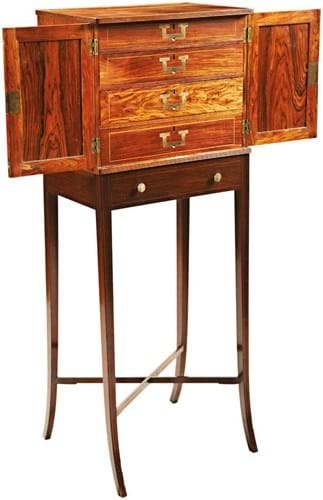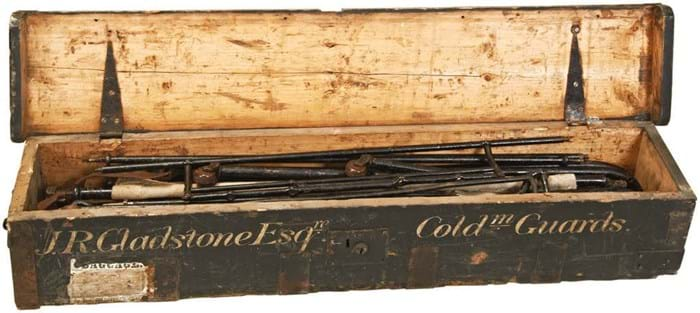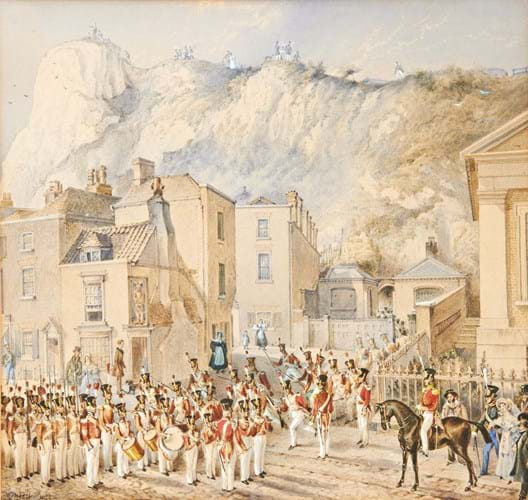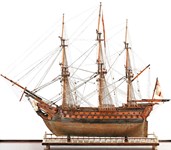
Made for travel and devised to be dismantled or folded, such furniture flourished among British Army officers during the rise and expansion of the empire in the 19th and 20th centuries.
Not only was it made to be strong and sturdy to withstand the long arduous journeys, but many incorporated discreet and hidden features, such as hinges, to make them look like domestic furniture when reassembled in a tent or ship.
Used to carry everything from clothes to crockery, there was apparently no limit to the campaign furniture an officer would take with him if he could afford to: The Times noted in 1858 that Sir Colin Campbell’s baggage train at Lucknow in India “extended for eighteen miles”.
As warfare changed, demand declined and by the 1900s many of the independent makers of campaign furniture began to disappear.
It has since become a wellestablished branch of the antique furniture market, appealing to collectors with an interest in military history as well as interior designers and home decorators attracted by its clean lines and timeless aesthetic, but buyers should be picky.
“Campaign furniture has become a buzzword for a lot of pieces advertised for sale in recent years, regardless of whether they are or not,” says Sean Clarke of Christopher Clarke Antiques, a second-generation dealer with his brother Simon who specialises in campaign furniture in Stow-on-the- Wold.
Make an order
This spring the pair hold their 32nd exhibition, Receiving Orders, which takes place until April 17 and features 70 items of 18th, 19th and 20th century campaign furniture and travel equipment. Clarke describes it as “the most interesting collection of provenanced items” the Cotswolds firm has offered in 20 years of holding specialist shows.
Leading the exhibition are three pieces of campaign furniture once owned by high-ranking soldiers serving with the East India Company as it secured control of India during the late 18th and early 19th century.
To offer three such pieces simultaneously is “exceptional”, says Clarke. “Campaign furniture with such a rich and early provenance is naturally harder to find. We would normally find one such piece every three or four years.”
A combination of luck and lockdown has brought these items “out of the woodwork”, he adds. The most important is an Englishmade campaign chest owned by Lt Col Robert Clement Garnham (1782-1827), an aide de camp to Sir Stamford Raffles, the founder of modern Singapore, who also took part in the invasion of Java in 1811. Crucially, it is believed to be the earliest-known and dateable campaign chest in the classical campaign-style form that the dealership knows of.
“Although we have had several earlier campaign chests, they were stepping stones in the design of what became the standardised military chest – that is made in two parts with no overhanging edges, brass bound with flush handles and removable feet,” says Clarke.
Based on the details available on Garnham’s sea voyages between Britain, Java and India, the chest has been dated to between May 1, 1822, and June 18, 1825. (It is significantly earlier than the next known example, which is dated c.1835.)
Designed to break down into two parts, the chest was spotted by the gallery at an auction in Essex last year. (For more on this see ATG No 2464).
Completing the trio are two Anglo-Indian teak trunks that originally belonged to Lt Col Caldwell (1763-1839) of the HEIC’s Bengal Army and Lt Col Gummer (b.1779) of the Madras Native Infantry.
Caldwell commanded the artillery at the decisive battle of Seringapatam in 1799, which marked the end of Tipu Sultan, the Tiger of Mysore, and was present at the surrender.
“The owner of this trunk had a rich military history and was heavily involved in many of the battles that cemented British rule in India,” says Clarke.
“Items belonging to soldiers that were at Seringapatam do not come on the market often and hold great interest to collectors of the British in India. Caldwell also commanded the artillery for the invasion of Java in 1811 and there is a good chance that he knew Garnham.”

Capt Alsager’s Chinese Export cabinet on stand – £2450 at 'Receiving Orders' at Christopher Clarke Antiques.
Other show highlights include a Chinese Export cabinet on stand that belonged to Richard Alsager (1781- 1841), a captain in the East India Company who made several voyages between England, India and China trading goods for the company and himself between 1817-26.
He became an MP in 1835 and a detailed account of his journeys survives in testimony he gave to the House of Lords on the affairs of the East India Company. There is also a Hill & Millard iron campaign bed that was slept in by John Robert Gladstone (1852-26), the nephew of Prime Minster Gladstone, when he was in the Coldstream Guards. The bed, which retains its original packing case, would have been used by John in the Egyptian War of 1882.

JR Gladstone’s camp bed by Hill & Millard – £1150 at 'Receiving Orders' at Christopher Clarke Antiques.
Dover military life
Offering a glimpse of military life back in England is an early 19th watercolour of Dover’s Grand Shaft Barracks. The Grand Shaft was a series of spiral staircases built between 1806-09 as a quick means of communication and movement between the barracks on the Western Heights and the town below should Napoleon invade England.

'Grand Shaft Barracks' by William Heath – £1950 at 'Receiving Orders' at Christopher Clarke Antiques.
With provenance to the personal collection of the late London dealer Jack Webb (1923-2019), the 14¾ x 15¼in (37 x 39cm) work by William Heath (1794-1840) shows young soldiers in the 5th Northumberland Regiment of Foot preparing to parade on Dover’s Snargate Street before being sent abroad.
Overall, prices range from £115 for a pint lipped rum measure, which is part of a collection of items relating to the tradition of issuing rum, to £8650 for Lt Col Garnham’s early campaign chest.














